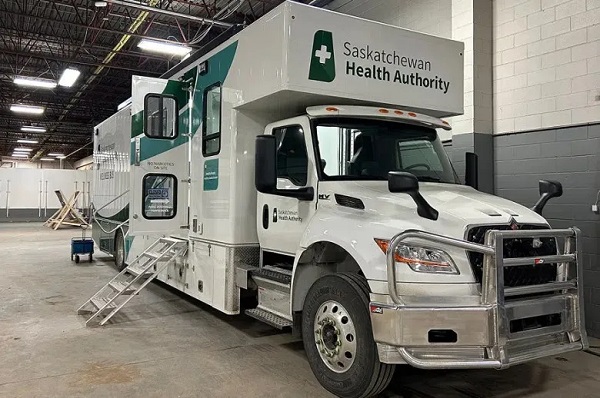Addictions
New RCMP program steering opioid addicted towards treatment and recovery

News release from Alberta RCMP
Virtual Opioid Dependency Program serves vulnerable population in Red Deer
Since April 2024, your Alberta RCMP’s Community Safety and Well-being Branch (CSWB) has been piloting the Virtual Opioid Dependency Program (VODP) program in Red Deer to assist those facing opioid dependency with initial-stage intervention services. VODP is a collaboration with the Government of Alberta, Recovery Alberta, and the Alberta RCMP, and was created to help address opioid addiction across the province.
Red Deer’s VODP consists of two teams, each consisting of a police officer and a paramedic. These teams cover the communities of Red Deer, Innisfail, Blackfalds and Sylvan Lake. The goal of the program is to have frontline points of contact that can assist opioid users by getting them access to treatment, counselling, and life-saving medication.
The Alberta RCMP’s role in VODP:
- Conducting outreach in the community, on foot, by vehicle, and even UTV, and interacting with vulnerable persons and talking with them about treatment options and making VODP referrals.
- Attending calls for service in which opioid use may be a factor, such as drug poisonings, open drug use in public, social diversion calls, etc.
- Administering medication such as Suboxone and Sublocade to opioid users who are arrested and lodged in RCMP cells and voluntarily wish to participate in VODP; these medications help with withdrawal symptoms and are the primary method for treating opioid addiction. Individuals may be provided ongoing treatment while in police custody or incarceration.
- Collaborating with agencies in the treatment and addiction space to work together on client care. Red Deer’s VODP chairs a quarterly Vulnerable Populations Working Group meeting consisting of a number of local stakeholders who come together to address both client and community needs.
While accountability for criminal actions is necessary, the Alberta RCMP recognizes that opioid addiction is part of larger social and health issues that require long-term supports. Often people facing addictions are among offenders who land in a cycle of criminality. As first responders, our officers are frequently in contact with these individuals. We are ideally placed to help connect those individuals with the VODP. The Alberta RCMP helps those individuals who wish to participate in the VODP by ensuring that they have access to necessary resources and receive the medical care they need, even while they are in police custody.
Since its start, the Red Deer program has made nearly 2,500 referrals and touchpoints with individuals, discussing VODP participation and treatment options. Some successes of the program include:
- In October 2024, Red Deer VODP assessed a 35-year-old male who was arrested and in police custody. The individual was put in contact with medical care and was prescribed and administered Suboxone. The team members did not have any contact with the male again until April 2025 when the individual visited the detachment to thank the team for treating him with care and dignity while in cells, and for getting him access to treatment. The individual stated he had been sober since, saying the treatment saved his life.
- In May 2025, the VODP team worked with a 14-year-old female who was arrested on warrants and lodged in RCMP cells. She had run away from home and was located downtown using opioids. The team spoke to the girl about treatment, was referred to VODP, and was administered Sublocade to treat her addiction. During follow-up, the team received positive feedback from both the family and the attending care providers.
The VODP provides same-day medication starts, opioid treatment transition services, and ongoing opioid dependency care to people anywhere in Alberta who are living with opioid addiction. Visit vodp.ca to learn more.
“This collaboration between Alberta’s Government, Recovery Alberta and the RCMP is a powerful example of how partnerships between health and public safety can change lives. The Virtual Opioid Dependency Program can be the first step in a person’s journey to recovery,” says Alberta’s Minister of Mental Health and Addiction Rick Wilson. “By connecting people to treatment when and where they need it most, we are helping build more paths to recovery and to a healthier Alberta.”
“Part of the Alberta RCMP’s CSWB mandate is the enhancement of public safety through community partnerships,” says Supt. Holly Glassford, Detachment Commander of Red Deer RCMP. “Through VODP, we are committed to building upon community partnerships with social and health agencies, so that we can increase accessibility to supports in our city and reduce crime in Red Deer. Together we are creating a stronger, safer Alberta.”
Addictions
Saskatchewan launches small fleet of wellness buses to expand addictions care

By Alexandra Keeler
Across Canada, mobile health models are increasingly being used to offer care to rural and underserved communities
Saskatchewan has launched a small fleet of mobile wellness buses to improve access to primary health care, mental health and addiction services in the province.
The first bus began operating in Regina on Feb. 12. Another followed in Prince Albert on March 21. Saskatoon’s bus was unveiled publicly on April 9. All three are former coach buses that have been retrofitted to provide health care to communities facing barriers to access.
“Mobile health units are proven to improve outcomes for people facing barriers to healthcare,” Kayla DeMong, the executive director of addiction treatment centre Prairie Harm Reduction, told Canadian Affairs in an email.
“We fully support this innovative approach and are excited to work alongside the health bus teams to ensure the people we support receive the care they need, when and where they need it.”
Wellness buses
Like all provinces, Saskatchewan has been grappling with the opioid crisis.
In 2023, an estimated 457 individuals died from overdoses in the province. In 2024, that number fell to 346. But the province continues to struggle with fatal and non-fatal overdoses.
In late February, Saskatoon firefighters responded to more than 25 overdoses in a single 24-hour period. Just over a week later, they responded to 37 overdoses within another 24-hour window.
Saskatchewan’s wellness buses are part of the province’s plan to address these problems. In April 2025, the province announced $2.4 million to purchase and retrofit three coach buses, plus $1.5 million in annual operating funds.
The buses operate on fixed schedules at designated locations around each city. Each bus is staffed with a nurse practitioner, nurse and assessor coordinator who offer services such as overdose reversal kits, addiction medicine and mental health referrals.
“By bringing services directly to where people are, the health buses foster safer, more welcoming spaces and help build trusting relationships between community members and care providers,” said DeMong, executive director of Prairie Harm Reduction.
Saskatoon-based Prairie Harm Reduction is one of the local organizations that partners with the buses to provide additional support services. Prairie Harm Reduction provides a range of family, youth and community supports, and also houses the province’s only fixed supervised consumption site.
The mobile model
Saskatchewan is not the only province using wellness buses. Across Canada, mobile health models are increasingly being used to expand access to care in rural and underserved communities.
In Kingston, Ont., the Street Health Centre operates a retrofitted RV called PORCH (Portable Outreach Care Hub) that serves individuals struggling with homelessness and addiction.
“Our outreach services are extremely popular with our clients and community partners,” Donna Glasspoole, manager at Street Health Centre, said in an emailed statement.
“PORCH hits the road two to three days/week and offers a variety of services, which are dependent on the health care providers and community partners aboard.”
Street Health Centre also has a shuttle service that picks up clients in shelters and brings them to medical clinics or addiction medicine clinics.
The PORCH vehicles are not supported by provincial funding, but instead rely on support from the United Way and other grants. Glasspoole says the centre’s permanent location — which does receive government funding — is more cost-effective to operate.
“The vehicles are expensive to operate and our RV is not great in winter months and requires indoor parking,” she said.

Politically palatable
Many mobile health models currently do not provide controversial services such as supervised drug consumption.
The Saskatchewan Health Authority told Canadian Affairs the province’s new wellness buses will not offer supervised consumption services or safer supply, where drug users are given prescribed opioids as an alternative to toxic street drugs.
“There are no plans to provide supervised consumption services from the wellness buses,” Saskatchewan Health Authority spokesperson Courtney Markewich told Canadian Affairs in a phone call.
This limited scope may make mobile services more politically palatable in provinces that have resisted harm reduction measures.
In Ontario, some harm reduction programs have shifted to mobile models following Premier Doug Ford’s decision to suspend supervised consumption services located within 200 metres of schools and daycares.
In April, Toronto Public Health ended operations at its Victoria Street fixed consumption site, replacing it with street outreach and mobile vans.
The Ontario government’s decision to close the sites is part of a broader pivot away from harm reduction. The province is investing $378 million to transition suspended sites into 19 new “HART Hubs” that offer primary care, mental health, addictions treatment and other supports.
Glasspoole says that what matters most is not whether services are provided at fixed or mobile locations, but how care is delivered.
Models that “reduce barriers to care, [are] non-judgemental, and [are staffed by] trauma-informed providers” are what lead more people toward treatment and recovery, she said in her email.
In Saskatchewan, DeMong hopes the province’s new wellness buses help address persistent service gaps and build trust with underserved communities.
“This initiative is a vital step toward filling long-standing gaps in the continuum of care by providing low-barrier, community-based access to health-care services,” she said.
This article was produced through the Breaking Needles Fellowship Program, which provided a grant to Canadian Affairs, a digital media outlet, to fund journalism exploring addiction and crime in Canada. Articles produced through the Fellowship are co-published by Break The Needle and Canadian Affairs.
Subscribe to Break The Needle
Addictions
Man jailed for trafficking diverted safer supply drugs, sparking fresh debate over B.C. drug policies

Nanaimo drug trafficker’s case is further evidence of safer supply diversion. But some sources say even diverted drugs reduce harm
In early May, 68-year-old Ronald Schilling of Nanaimo, B.C., was sentenced to three years in prison for trafficking street drugs such as fentanyl and meth — as well as government-supplied opioids.
When authorities had arrested Schilling two years earlier, they had found him in possession of more than 80 government-supplied opioid pill bottles labeled with other patients’ names.
Those pills had been dispensed to patients under B.C.’s “prescribed alternatives” program, more commonly known as safer supply. The program aims to reduce overdose deaths by dispensing pharmaceutical opioids to drug users as an alternative to toxic street drugs.
In Schilling, patients of this program had found a drug dealer who was willing to give them harder drugs — such as fentanyl — in exchange for their prescription opioids. Schilling would in turn sell their prescription opioids to others.
“Mr. Schilling preyed upon people who were taking the safe supply drug,” Provincial Court Judge Karen Whonnock said during the sentencing hearing.
Schilling’s case is further evidence that safer supply opioids are making their way to the streets — and having unintended negative consequences. However, some sources say even diverted pills reduce harm if they flood the market with safer drugs.
‘Upside Down’
Schilling, a former charity worker, developed a cocaine addiction after the sudden death of his partner. He ultimately turned to drug trafficking to fund his addiction, according to his lawyer.
In court, the prosecution described Schilling as operating a mid-level drug trafficking scheme that exploited B.C.’s safer supply program.
Schilling coordinated with multiple dealers to source both illicit and prescription drugs, and had at least three individuals working under him. His text messages showed he would arrange to meet clients near Nanaimo’s Outreach Pharmacy to trade potent street drugs for the prescribed medications they had just received.
He operated under the name “Upside Down Inc.” — “down” being a street reference to fentanyl — and had business cards to match. To reassure users that the street drugs were safe, he would have them tested at a local overdose prevention site.
‘Predatory behaviour’
While Schilling’s case is unusual, it adds to the growing body of evidence that provincial safer supply programs are not always being used as intended.
In one example, a B.C. government report released in February revealed that more than 60 pharmacies were involved in a kick-back scheme, offering patients cash or rewards to fill safer supply prescriptions they did not need. Some of those drugs were then sold on the black market.
Collen Middleton, a co-founder of the Nanaimo Area Public Safety Association, refers to safer supply drugs as the “perfect consumer product.”
“They are a product that produces its own demand, because it’s addictive,” said Middleton, whose neighbourhood association is a vocal critic of safer supply.
One of Middleton’s concerns is that safer supply drugs are presented as safe, despite being addictive themselves. He says this makes them an effective gateway to more dangerous street drugs like fentanyl.
“Those drugs are being marketed as safe to kids … [so] you’re bringing more people into using addictive drugs, more abuse, more predatory behaviour toward a vulnerable segment of the population,” he said.
The B.C. Ministry of Health told Canadian Affairs in an emailed statement that it takes the “diversion of prescription medications … very seriously.”
“The unauthorized distribution is illegal and puts the public at risk,” it said.
In response to the B.C. pharmacy scandal, the province tightened its protocols for dispensing prescription opioids. All new and most existing patients must take prescription opioids under the supervision of health-care professionals, a protocol known as witnessed dosing. In rare cases, existing clients may continue to take their doses offsite if the prescriber views the risk of diversion as low.
Mixed evidence
In its statement to Canadian Affairs, B.C.’s health ministry also said its safer supply program “plays an important role in reducing substance use-related harms” and can lower overdose risk by as much as 91 per cent.
This figure comes from a 2024 B.C. study published in the British Medical Journal. That study found individuals prescribed pharmaceutical opioids early in the pandemic were 91 per cent less likely to die from any cause in the week after receiving at least four days of safer supply opioids, compared to a control group.
The study only tracked outcomes during the week following prescription fills. It did not verify whether individuals took the opioids as prescribed.
A study published in April in The Lancet Public Health shows B.C.’s safer supply programs are linked to improved short-term health outcomes, including fewer overdoses and hospital visits.
However, a population-level study in JAMA Health Forum found no significant reduction in overdoses or mortality associated with B.C.’s safer supply and decriminalization policies. It also suggested possible increases in emergency department visits and hospitalizations.
Comprehensive long-term research on the health impacts of Canadian safer supply programs is limited.
Creating a market
Some sources say the diversion of prescription opioids may be less harmful than the alternatives.
“If you could replace [street] drugs with safer pharmaceutical alternatives, people’s needs would be met,” said Perry Kendall, B.C.’s former provincial health officer and a long-time harm reduction advocate.
“They wouldn’t have to turn to the illicit market, and their risk of a toxic drug overdose would be significantly reduced.”
In Kendall’s view, Schilling was in some ways functioning as a harm-reduction worker.
“[Schilling] was kind of offering a harm reduction service, as well as supplying people with the drugs they wanted,” Kendall said.
Kendall’s views are echoed in a 2023 B.C. government review that notes diversion of safer supply drugs to people already at risk of drug poisoning may be beneficial. But the review also acknowledges that diversion to users who would not otherwise use unregulated drugs is harmful.
Still, Kendall acknowledged a fundamental issue: “[Safer supply opioids don’t] really give you the same high [as fentanyl]. So if you can trade [them] to … get what you’re looking for, which is fentanyl, then that’s what you will do.”
Leonard Krog, the mayor of Nanaimo, says it is clear that, within Nanaimo, B.C.’s policies to help drug users are making it easier for dealers to sell their toxic drugs.
“We have a safe injection site next to City Hall, and there’s no question dealers are coming down here and they’re selling their stuff, because the market’s right here,” said Krog.
But Kendall warns that pulling back on decriminalization and safer supply programs creates a dangerous gap.
“The daftest thing you can do is create a market of desperate people and then fail to fill it,” said Kendall. “Somebody’s going to meet those needs — and they’re not going to be law-abiding citizens.”
Krog is unconvinced.
“If we make it easier for the wolves to successfully exploit the sheep, is that a good thing?”
This article was produced through the Breaking Needles Fellowship Program, which provided a grant to Canadian Affairs, a digital media outlet, to fund journalism exploring addiction and crime in Canada. Articles produced through the Fellowship are co-published by Break The Needle and Canadian Affairs.
Subscribe to Break The Needle
-

 Brownstone Institute1 day ago
Brownstone Institute1 day agoAnthony Fauci Gets Demolished by White House in New Covid Update
-

 Business1 day ago
Business1 day agoSobering reality check – Trump is right: Canada’s economy can’t survive a fair trade agreement with the US
-

 Crime1 day ago
Crime1 day agoMexican Cartels Expanding Operations in Canada, Using Indigenous Reserves as Factory Hubs
-

 Business1 day ago
Business1 day agoOttawa must listen to the West
-

 Fraser Institute1 day ago
Fraser Institute1 day agoDeclining stature of foreign affairs minister underscores Canada’s waning influence on world stage
-

 Automotive20 hours ago
Automotive20 hours agoCanada’s EV house of cards is close to collapsing
-

 International1 day ago
International1 day agoMusk deletes X post after Trump’s attorney says Epstein ‘had no information to hurt’ the president
-

 Alberta1 day ago
Alberta1 day agoToo Graphic For A Press Conference But Fine For Kids In School?


